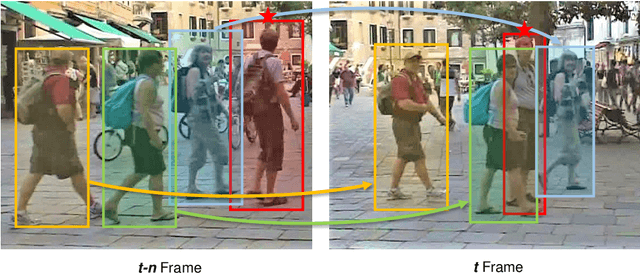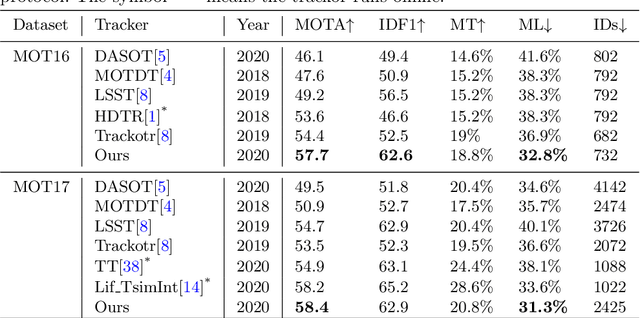Tianyi Liang
RouteWinFormer: A Route-Window Transformer for Middle-range Attention in Image Restoration
Apr 23, 2025Abstract:Transformer models have recently garnered significant attention in image restoration due to their ability to capture long-range pixel dependencies. However, long-range attention often results in computational overhead without practical necessity, as degradation and context are typically localized. Normalized average attention distance across various degradation datasets shows that middle-range attention is enough for image restoration. Building on this insight, we propose RouteWinFormer, a novel window-based Transformer that models middle-range context for image restoration. RouteWinFormer incorporates Route-Windows Attnetion Module, which dynamically selects relevant nearby windows based on regional similarity for attention aggregation, extending the receptive field to a mid-range size efficiently. In addition, we introduce Multi-Scale Structure Regularization during training, enabling the sub-scale of the U-shaped network to focus on structural information, while the original-scale learns degradation patterns based on generalized image structure priors. Extensive experiments demonstrate that RouteWinFormer outperforms state-of-the-art methods across 9 datasets in various image restoration tasks.
Consensus Entropy: Harnessing Multi-VLM Agreement for Self-Verifying and Self-Improving OCR
Apr 16, 2025Abstract:The Optical Character Recognition (OCR) task is important for evaluating Vision-Language Models (VLMs) and providing high-quality data sources for LLM training data. While state-of-the-art VLMs show improved average OCR accuracy, they still struggle with sample-level quality degradation and lack reliable automatic detection of low-quality outputs. We introduce Consensus Entropy (CE), a training-free post-inference method that quantifies OCR uncertainty by aggregating outputs from multiple VLMs. Our approach exploits a key insight: correct VLM OCR predictions converge in output space while errors diverge. We develop a lightweight multi-model framework that effectively identifies problematic samples, selects the best outputs and combines model strengths. Experiments across multiple OCR benchmarks and VLMs demonstrate that CE outperforms VLM-as-judge approaches and single-model baselines at the same cost and achieves state-of-the-art results across multiple metrics. For instance, our solution demonstrates: achieving 15.2% higher F1 scores than VLM-as-judge methods in quality verification, delivering 6.0% accuracy gains on mathematical calculation tasks, and requiring rephrasing only 7.3% of inputs while maintaining overall performance. Notably, the entire process requires neither training nor supervision while maintaining plug-and-play functionality throughout.
CritiQ: Mining Data Quality Criteria from Human Preferences
Feb 26, 2025Abstract:Language model heavily depends on high-quality data for optimal performance. Existing approaches rely on manually designed heuristics, the perplexity of existing models, training classifiers, or careful prompt engineering, which require significant expert experience and human annotation effort while introduce biases. We introduce CritiQ, a novel data selection method that automatically mines criteria from human preferences for data quality with only $\sim$30 human-annotated pairs and performs efficient data selection. The main component, CritiQ Flow, employs a manager agent to evolve quality criteria and worker agents to make pairwise judgments. We build a knowledge base that extracts quality criteria from previous work to boost CritiQ Flow. Compared to perplexity- and classifier- based methods, verbal criteria are more interpretable and possess reusable value. After deriving the criteria, we train the CritiQ Scorer to give quality scores and perform efficient data selection. We demonstrate the effectiveness of our method in the code, math, and logic domains, achieving high accuracy on human-annotated test sets. To validate the quality of the selected data, we continually train Llama 3.1 models and observe improved performance on downstream tasks compared to uniform sampling. Ablation studies validate the benefits of the knowledge base and the reflection process. We analyze how criteria evolve and the effectiveness of majority voting.
GAOKAO-Eval: Does high scores truly reflect strong capabilities in LLMs?
Dec 13, 2024Abstract:Large Language Models (LLMs) are commonly evaluated using human-crafted benchmarks, under the premise that higher scores implicitly reflect stronger human-like performance. However, there is growing concern that LLMs may ``game" these benchmarks due to data leakage, achieving high scores while struggling with tasks simple for humans. To substantively address the problem, we create GAOKAO-Eval, a comprehensive benchmark based on China's National College Entrance Examination (Gaokao), and conduct ``closed-book" evaluations for representative models released prior to Gaokao. Contrary to prevailing consensus, even after addressing data leakage and comprehensiveness, GAOKAO-Eval reveals that high scores still fail to truly reflect human-aligned capabilities. To better understand this mismatch, We introduce the Rasch model from cognitive psychology to analyze LLM scoring patterns and identify two key discrepancies: 1) anomalous consistent performance across various question difficulties, and 2) high variance in performance on questions of similar difficulty. In addition, We identified inconsistent grading of LLM-generated answers among teachers and recurring mistake patterns. we find that the phenomenons are well-grounded in the motivations behind OpenAI o1, and o1's reasoning-as-difficulties can mitigate the mismatch. These results show that GAOKAO-Eval can reveal limitations in LLM capabilities not captured by current benchmarks and highlight the need for more LLM-aligned difficulty analysis.
TextCenGen: Attention-Guided Text-Centric Background Adaptation for Text-to-Image Generation
Apr 18, 2024Abstract:Recent advancements in Text-to-image (T2I) generation have witnessed a shift from adapting text to fixed backgrounds to creating images around text. Traditional approaches are often limited to generate layouts within static images for effective text placement. Our proposed approach, TextCenGen, introduces a dynamic adaptation of the blank region for text-friendly image generation, emphasizing text-centric design and visual harmony generation. Our method employs force-directed attention guidance in T2I models to generate images that strategically reserve whitespace for pre-defined text areas, even for text or icons at the golden ratio. Observing how cross-attention maps affect object placement, we detect and repel conflicting objects using a force-directed graph approach, combined with a Spatial Excluding Cross-Attention Constraint for smooth attention in whitespace areas. As a novel task in graphic design, experiments indicate that TextCenGen outperforms existing methods with more harmonious compositions. Furthermore, our method significantly enhances T2I model outcomes on our specially collected prompt datasets, catering to varied text positions. These results demonstrate the efficacy of TextCenGen in creating more harmonious and integrated text-image compositions.
Enhancing the Association in Multi-Object Tracking via Neighbor Graph
Jul 01, 2020



Abstract:Most modern multi-object tracking (MOT) systems follow the tracking-by-detection paradigm. It first localizes the objects of interest, then extracting their individual appearance features to make data association. The individual features, however, are susceptible to the negative effects as occlusions, illumination variations and inaccurate detections, thus resulting in the mismatch in the association inference. In this work, we propose to handle this problem via making full use of the neighboring information. Our motivations derive from the observations that people tend to move in a group. As such, when an individual target's appearance is seriously changed, we can still identify it with the help of its neighbors. To this end, we first utilize the spatio-temporal relations produced by the tracking self to efficiently select suitable neighbors for the targets. Subsequently, we construct neighbor graph of the target and neighbors then employ the graph convolution networks (GCN) to learn the graph features. To the best of our knowledge, it is the first time to exploit neighbor cues via GCN in MOT. Finally, we test our approach on the MOT benchmarks and achieve state-of-the-art performance in online tracking.
 Add to Chrome
Add to Chrome Add to Firefox
Add to Firefox Add to Edge
Add to Edge